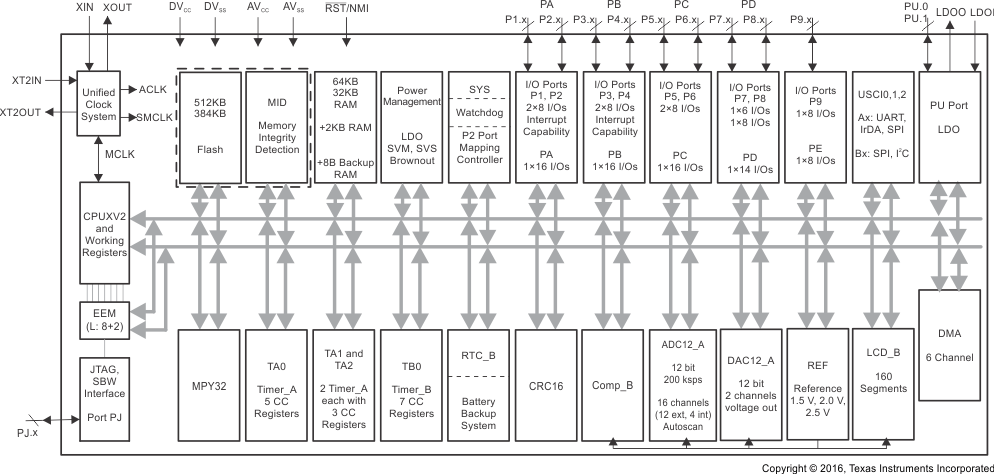JAJSCD5A August 2016 – August 2016 MSP430F6459-HIREL
PRODUCTION DATA.
- 1デバイスの概要
- 2改訂履歴
- 3Device Comparison
- 4Terminal Configuration and Functions
-
5Specifications
- 5.1 Absolute Maximum Ratings
- 5.2 ESD Ratings
- 5.3 Recommended Operating Conditions
- 5.4 Active Mode Supply Current Into VCC Excluding External Current
- 5.5 Low-Power Mode Supply Currents (Into VCC) Excluding External Current
- 5.6 Low-Power Mode With LCD Supply Currents (Into VCC) Excluding External Current
- 5.7 Schmitt-Trigger Inputs - General-Purpose I/O
- 5.8 Leakage Current - General-Purpose I/O
- 5.9 Outputs - General-Purpose I/O (Full Drive Strength)
- 5.10 Outputs - General-Purpose I/O (Reduced Drive Strength)
- 5.11 Thermal Resistance Characteristics for PZ Package
- 5.12 Typical Characteristics - Outputs, Reduced Drive Strength (PxDS.y = 0)
- 5.13 Typical Characteristics - Outputs, Full Drive Strength (PxDS.y = 1)
- 5.14 Timing and Switching Characteristics
-
6Detailed Description
- 6.1 Overview
- 6.2 CPU
- 6.3 Instruction Set
- 6.4 Operating Modes
- 6.5 Interrupt Vector Addresses
- 6.6 Memory Organization
- 6.7 Bootloader (BSL)
- 6.8 JTAG Operation
- 6.9 Flash Memory
- 6.10 Memory Integrity Detection (MID)
- 6.11 RAM
- 6.12 Backup RAM
- 6.13
Peripherals
- 6.13.1 Digital I/O
- 6.13.2 Port Mapping Controller
- 6.13.3 Oscillator and System Clock
- 6.13.4 Power-Management Module (PMM)
- 6.13.5 Hardware Multiplier (MPY)
- 6.13.6 Real-Time Clock (RTC_B)
- 6.13.7 Watchdog Timer (WDT_A)
- 6.13.8 System Module (SYS)
- 6.13.9 DMA Controller
- 6.13.10 Universal Serial Communication Interface (USCI)
- 6.13.11 Timer TA0
- 6.13.12 Timer TA1
- 6.13.13 Timer TA2
- 6.13.14 Timer TB0
- 6.13.15 Comparator_B
- 6.13.16 ADC12_A
- 6.13.17 DAC12_A
- 6.13.18 CRC16
- 6.13.19 Voltage Reference (REF) Module
- 6.13.20 LCD_B
- 6.13.21 LDO and PU Port
- 6.13.22 Embedded Emulation Module (EEM) (L Version)
- 6.13.23 Peripheral File Map
- 6.14
Input/Output Schematics
- 6.14.1 Port P1, P1.0 to P1.7, Input/Output With Schmitt Trigger
- 6.14.2 Port P2, P2.0 to P2.7, Input/Output With Schmitt Trigger
- 6.14.3 Port P3, P3.0 to P3.7, Input/Output With Schmitt Trigger
- 6.14.4 Port P4, P4.0 to P4.7, Input/Output With Schmitt Trigger
- 6.14.5 Port P5, P5.0 and P5.1, Input/Output With Schmitt Trigger
- 6.14.6 Port P5, P5.2 to P5.7, Input/Output With Schmitt Trigger
- 6.14.7 Port P6, P6.0 to P6.7, Input/Output With Schmitt Trigger
- 6.14.8 Port P7, P7.2, Input/Output With Schmitt Trigger
- 6.14.9 Port P7, P7.3, Input/Output With Schmitt Trigger
- 6.14.10 Port P7, P7.4 to P7.7, Input/Output With Schmitt Trigger
- 6.14.11 Port P8, P8.0 to P8.7, Input/Output With Schmitt Trigger
- 6.14.12 Port P9, P9.0 to P9.7, Input/Output With Schmitt Trigger
- 6.14.13 Port PU.0, PU.1 Ports
- 6.14.14 Port J, PJ.0 JTAG Pin TDO, Input/Output With Schmitt Trigger or Output
- 6.14.15 Port J, PJ.1 to PJ.3 JTAG Pins TMS, TCK, TDI/TCLK, Input/Output With Schmitt Trigger or Output
- 6.15 Device Descriptors
- 7Applications, Implementation, and Layout
- 8デバイスおよびドキュメントのサポート
- 9メカニカル、パッケージ、および注文情報
1 デバイスの概要
1.1 特長
-
低い電源電圧範囲:
3.6Vから最低1.8Vまで - 非常に低い消費電力
- アクティブ・モード(AM):
すべてのシステム・クロックがアクティブ:
8MHz、3V、フラッシュ・プログラム実行で295µA/MHz (標準値) - スタンバイ・モード(LPM3):
水晶振動子によるウォッチドッグ、電源スーパーバイザが動作、すべてのRAMを保持、高速ウェークアップ:
2.2Vで2µA、3Vで2.2µA (標準値) - シャットダウン、リアルタイム・クロック(RTC)モード(LPM3.5):
シャットダウン・モード、水晶振動子によるアクティブRTC:
3Vで1.1µA (標準値) - シャットダウン・モード(LPM4.5):
3Vで0.45µA (標準値)
- アクティブ・モード(AM):
- スタンバイ・モードから3µs以内にウェークアップ(標準値)
- 16ビットRISCアーキテクチャ、拡張メモリ、最大20MHzのシステム・クロック
- 柔軟な電力管理システム
- プログラム可能な、レギュレートされたコア電源電圧を持つ、完全に統合されたLDO
- 電源電圧の管理、監視、およびブラウンアウト
- 統合クロック・システム
- FLL制御ループによる周波数安定化
- 低電力、低周波数の内部クロック・ソース(VLO)
- 低周波数のトリムされた内部基準ソース(REFO)
- 32kHzの水晶振動子(XT1)
- 最高32MHzの高周波数水晶振動子(XT2)
- 4つの16ビット・タイマと3、5、または7本のキャプチャ/比較レジスタ
- 3つのユニバーサル・シリアル通信インターフェイス(USCI)
- USCI_A0、USCI_A1、USCI_A2がそれぞれ次の機能をサポート
- 自動ボーレート検出機能付きの拡張UART
- IrDAエンコーダおよびデコーダ
- 同期SPI
- USCI_B0、USCI_B1、USCI_B2がそれぞれ次の機能をサポート
- I2C
- 同期SPI
- USCI_A0、USCI_A1、USCI_A2がそれぞれ次の機能をサポート
- 内部共有リファレンス、サンプル・アンド・ホールド、オートスキャン機能搭載の12ビットのA/Dコンバータ(ADC)
- 同期機能付きの2つの12ビットD/Aコンバータ(DAC)
- 電圧コンパレータ
- 最大160セグメントのコントラスト制御を搭載した内蔵LCDドライバ
- ハードウェア・マルチプライヤで32ビットの演算をサポート
- シリアルのオンボード・プログラミング、外部のプログラミング電圧不要
- 6チャネルの内部DMA
- 電源電圧バックアップ・スイッチ付きのRTCモジュール
1.2 アプリケーション
- アナログおよびデジタル・センサ・システム
- デジタル・モータの制御
- リモート・コントロール
- サーモスタット
- デジタル・タイマ
- ハンドヘルド・メータ
1.3 概要
TI MSP430™ファミリの超低消費電力マイクロコントローラは複数のデバイスで構成され、それぞれが各種のアプリケーションを対象とする異なるペリフェラルの組となっています。このアーキテクチャは5つの低消費電力モードを持ち、携帯用測定器用途でバッテリ駆動時間を延長するよう最適化されています。このデバイスには、強力な16ビットRISC CPU、16ビット・レジスタ、およびコンスタント・ジェネレータが搭載されており、コード効率が最大限に発揮されます。デジタル制御発振器(DCO)により、低消費電力モードからアクティブ・モードへ3µs (標準値)以内でウェークアップできます。
MSP430F6459-HIRELはマイクロコントローラで、3.3V LDO、4つの16ビット・タイマ、高性能の12ビットADC、3つのUSCI、ハードウェア・マルチプライヤ、DMA、アラーム機能付きのRTCモジュール、コンパレータ、および最大74本のI/Oピンが搭載されています。
これらのデバイスの代表的なアプリケーションとして、デジタル・センサ・システム、デジタル・モータの制御、リモート・コントロール、サーモスタット、デジタル・タイマ、ハンドヘルド・メータが挙げられます。
製品情報(1)
| 型番 | パッケージ | 本体サイズ(公称)(2) |
|---|---|---|
| MSP430F6459-HIREL | PZ (100) | 16.0mm×16.0mm |
(1) 最新のデバイス、パッケージ、および注文情報については、Section 9の「付録:パッケージ・オプション」または、www.ti.comのTI Webサイトを参照してください。
(2) ここに記載されているサイズは概略です。許容公差を含めたパッケージの寸法については、Section 9の「メカニカル・データ」を参照してください。
